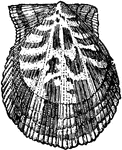
Brown-tail Moth
The Brown-tail (Euproctis chrysorrhoea) is a moth of the family Lymantriidae. It is distributed throughout…
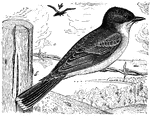
Kingbird
The genus Tyrannus is a group of large insect-eating birds in the Tyrant flycatcher family Tyrannidae.…
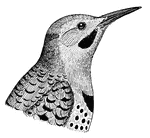
Northern Flicker
The Northern Flicker (Colaptes auratus) is a medium-sized member of the woodpecker family. It is native…

Io Moth Caterpillar
An illustration of a Io moth caterpillar. The io moth (Automeris io) is a very colorful North American…

Fallweb Worm Caterpillar
An illustration of a fallweb worm caterpillar. Fall webworm, Hyphantria cunea, is a moth in the family…

Fallweb Worm Caterpillar
An illustration of a fallweb worm caterpillar. Fall webworm, Hyphantria cunea, is a moth in the family…

Fallweb Worm Caterpillar
An illustration of a fallweb worm caterpillar. Fall webworm, Hyphantria cunea, is a moth in the family…
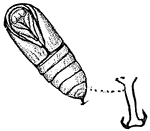
Fallweb Worm Pupa
An illustration of a fallweb worm pupa. Fall webworm, Hyphantria cunea, is a moth in the family Arctiidae…
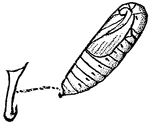
Fallweb Worm Pupa
An illustration of a fallweb worm pupa. Fall webworm, Hyphantria cunea, is a moth in the family Arctiidae…

Fallweb Worm Moth
An illustration of a fallweb worm moth. Fall webworm, Hyphantria cunea, is a moth in the family Arctiidae…

American Robin
The American Robin, Turdus migratorius, is a migratory songbird of the thrush family. It is named after…

Bluebird
The bluebirds are medium-sized, mostly insectivorous or omnivorous birds in the genus Sialia of the…
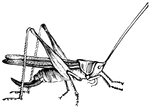
Cricket
Crickets, family Gryllidae (also known as "true crickets"), are insects somewhat related to grasshoppers…
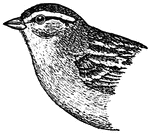
Chipping Sparrow
The Chipping Sparrow (Spizella passerina) is a species of American sparrow in the family Emberizidae.…

White-throated Sparrow
The White-throated Sparrow, Zonotrichia albicollis, is a passerine bird of the American sparrow family…
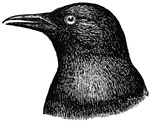
Crow
The true crows are large passerine birds that comprise the genus Corvus in the family Corvidae. Ranging…

Meadowlark
Meadowlarks are birds belonging to the genus Sturnella in the New World family Icteridae. This genus…
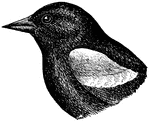
Red-winged Blackbird
The Red-winged Blackbird (Agelaius phoeniceus) is a passerine bird of the family Icteridae found in…

Red-winged Blackbird (Female)
The Red-winged Blackbird (Agelaius phoeniceus) is a passerine bird of the family Icteridae found in…
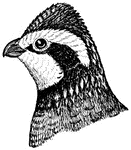
Northern Bobwhite
The Northern Bobwhite, Virginia Quail or (in its home range) Bobwhite Quail (Colinus virginianus) is…
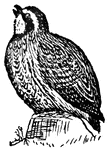
Northern Bobwhite
The Northern Bobwhite, Virginia Quail or (in its home range) Bobwhite Quail (Colinus virginianus) is…

Northern Bobwhite
The Northern Bobwhite, Virginia Quail or (in its home range) Bobwhite Quail (Colinus virginianus) is…

Common Pheasant
The Common Pheasant (Phasianus colchicus), is a bird in the pheasant family (Phasianidae). It is native…
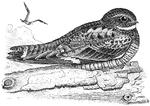
Nighthawk
Nighthawks are birds of the nightjar family in the New World subfamily Chordeilinae. They are medium-sized…
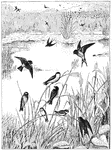
Swallow Roost
The Sand Martin (Riparia riparia) is a migratory passerine bird in the swallow family. This species…
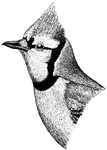
Blue Jay
The Blue Jay (Cyanocitta cristata) is a passerine bird, and a member of the family Corvidae native to…
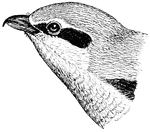
Great Grey Shrike
The Great Grey Shrike (Lanius excubitor) is a member of the shrike family. The Great Grey Shrike breeds…

Van Cortlandt Manor House
Originally, it was an 86,000-acre (350 km²) tract granted as a Patent to Stephanus Van Cortlandt in…
![Smilax is a genus of about 300-350 species, found in the tropics and subtropics worldwide. In China for example about 80 are found (39 of which are endemic), while there are 20 in North America north of Mexico[1]. They are climbing flowering plants, many of which are woody and/or thorny, in the monocotyledon family Smilacaceae, native throughout the tropical and warm temperate regions of the world. Common names include catbriers, greenbriers, prickly-ivys and smilaxes. "Sarsaparilla" (also zarzaparrilla, sarsparilla) is a name used specifically for the Jamaican S. regelii as well as a catch-all term in particular for American species. Occasionally, the non-woody species such as the Smooth Herbaceous Greenbrier (S. herbacea) are separated as genus Nemexia; they are commonly known by the rather ambiguous name "carrion flowers"](https://etc.usf.edu/clipart/57000/57029/57029_smilax_mth.gif)
Smilax
Smilax is a genus of about 300-350 species, found in the tropics and subtropics worldwide. In China…

Myrica
Myrica is a genus of about 35-50 species of small trees and shrubs in the family Myricaceae, order Fagales.…
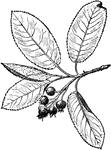
Amelanchier
Amelanchier, also known as shadbush, serviceberry, sarvisberry, juneberry, Saskatoon, shadblow, shadwood,…
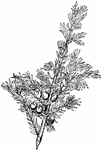
Juniper
Junipers are coniferous plants in the genus Juniperus of the cypress family Cupressaceae. Depending…

Phoebe's Nest
An illustration of a Phoebe's nest in a box. The genus Sayornis is a small group of medium-sized insect-eating…

Yellow-Bellied Sapsucker
From the woodpecker family, the Yellow-Bellied Sapsucker (Sphyrapicus varius) is known for drilling…
Sauroid
"One of a family of ganoid fishes including the lepidosteids and various extinct forms." -Whitney, 1911

Summer Savory
The Summer Savory (Satureja hortensis) is a flowering plant of the Lamiaceae family. The image shows…

Black Phoebe
The Black Phoebe (Sayornis nigricans) is a small bird of the Tyrant Flycatcher family (Tyrannidae).
Silver Scabbardfish
The silver scabbardfish (Lepidopus caudatus) is a cutlassfish in the Trichiuridae family.

Atlantic Horse Mackerel
The Atlantic Horse Mackerel or Scad (Trachurus trachurus) is a species of mackerel in the Carangidae…

Lefteye Flounder (Scaldfish)
The scaldfish (Arnoglossus laterna) is a species of lefteye flounder of the Bothidae family.
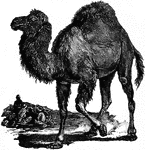
Dromedary
The Dromedary camel (Camelus dromedarius) is a large even-toed ungulate. It is often referred to as…
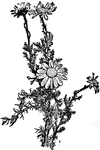
Chamomile
The name Chamomile or Camomile means "earth-apple", because of the applelike scent of the plant. It…
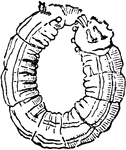
Cheese Fly Larva
Cheese flies are members of the family Piophilidae of flies (Diptera), including the members of two…

Climbing Perch
The Anabantidae are a family of perciform fish commonly called the climbing gouramies or climbing perches.…
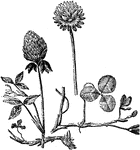
Clover
An illustration of white clover (left) and red clover (right). Clover (Trifolium), or trefoil, is a…
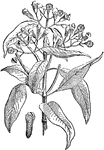
Clove Plant and Seed
Cloves (Syzygium aromaticum, syn. Eugenia aromaticum or Eugenia caryophyllata) are the aromatic dried…
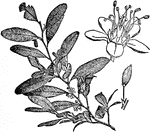
Coca Flower
Coca is a plant in the family Erythroxylaceae, native to north-western South America. The plant plays…
Coca Fruit
Coca is a plant in the family Erythroxylaceae, native to north-western South America. The plant plays…
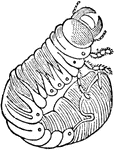
Cockchafer Larva
An illustration of a full grown cockchafer larva. The cockchafer (colloquially called may bug, billy…

Cockchafer Pupa
An illustration of a cockchafer pupa. The cockchafer (colloquially called may bug, billy witch, or spang…

Edward M. McCook
Edward Moody McCook (June 15. 1833 – September 9, 1909) was a lawyer, politician, distinguished Union…

Cockchafer
An illustration of a cockchafer. The cockchafer (colloquially called may bug, billy witch, or spang…
Cocoanut Palm Spadix
An illustration of a cocoanut palm's spadix. In botany, a spadix (pl. spadices) is a type of spike:…

Scammony
The scammony (Convolvulus scammonia) is a flowering plant of the bindweed family. R, the root.
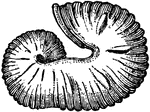
Scaphites equalis, Extinct Cephalopod Fossil
Scaphites equalis is a species of extinct cephalopods that thrived during the Cretaceous period. "A…

Dung Beetle
The dung beetle is an insect in the Scarabaeidae family and was a sacred icon to the Egyptians.
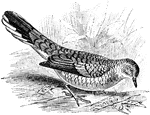
Scaly Ground Dove
The scaly ground dove (Scardafella squamosa) is a species of New World doves in the Columbidae family.

